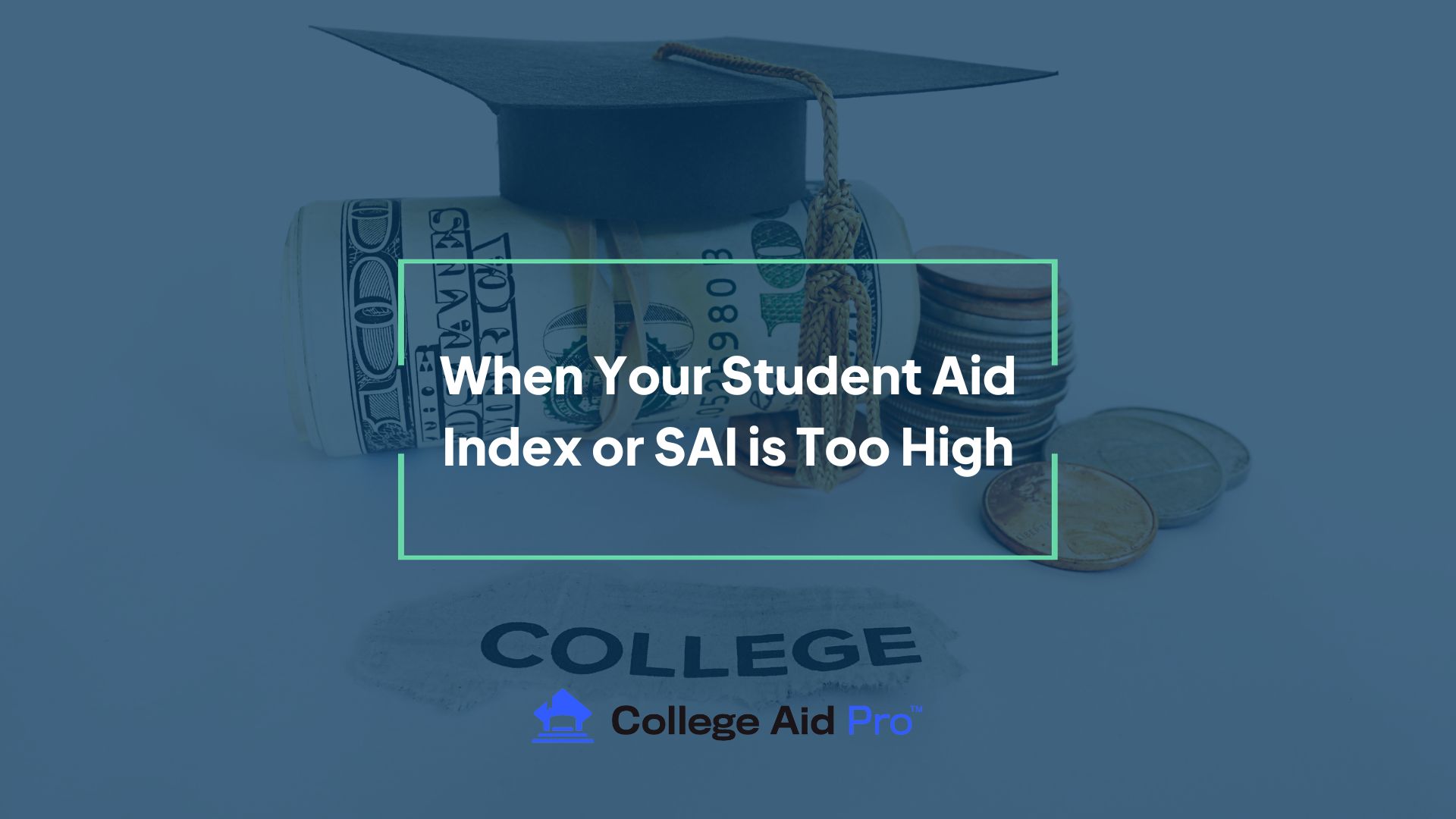When Your Student Aid Index (SAI) is Too High
Are you left scrambling after filling out the FAFSA because you didn’t get as much as you were hoping? This is likely due to your student aid index (SAI) being too high. Now you may be wondering what is a high SAI on the FAFSA and what does that mean. We’ll take a look at that along with options your family has to combat a high SAI on the FAFSA.
First, let’s look at what is a high SAI on the FAFSA. A high SAI can look different for everyone. Essentially, a high SAI means your student will receive fewer funds than you were hoping for. This is because the FAFSA has estimated you’ll provide X amount for your student’s tuition based on your income, savings, and other factors. Often, these estimates are extremely off-base and don’t take every financial responsibility into account, resulting in a high SAI and smaller or no grant funds.
But when your SAI is too high to be affordable, you do have several options. We will address this both for high school seniors with award letters in hand, and also take a look at what to do with younger students where Net Price Calculators indicate an student aid index amount you know you can’t afford.
Let’s discuss when your high school senior receives financial aid award letters from colleges that have admitted them and the student aid index listed is not going to work for your family.
Options When Your SAI is Too High for the Schools Your Student Was Admitted To
- Appeal – Don’t be afraid to contact the colleges your student is interested in attending and appeal the financial aid package. If you are applying for more need-based financial aid, you, the parent, will know the ins and outs of your financial situation best. That being said, encourage your student to write a letter explaining how this school is their top choice, why, and what they will add to the campus and student body. If you are seeking more merit-based aid, it’s best to let your student do the contacting, but you can coach them through a call or help them craft an email that outlines the appeal. There are really two types of negotiation tactics in this instance:
- More Need-Based Aid – Follow the school’s financial aid appeals process and provide proof of why you can’t afford what the school thinks you can afford. (Colleges usually only take into account “special circumstances” that weren’t reflected in your financial aid filing.)
- More Merit-Based Aid – It’s easiest to negotiate when you have better offers in hand from other colleges similar to the school. Have your student talk to the admissions office and offer to send them the award letters from other schools, stressing why this school would still be the top choice with the right scholarship amount.
- Choose the Lowest Priced Option – Hopefully your student had an in-state public college or other more affordable school in their mix. It is difficult to turn down admissions offers from more expensive and more prestigious schools, but if it will allow your student to graduate debt-free, it’s worthy of further consideration.
- Keep Looking – During spring of their senior year, you may think it is too late for your student to look at other colleges. This is not the case. There are still many schools accepting applications. Your student may find other schools that are willing to provide more need-based and/or merit-based aid. Check for schools with late or rolling application deadlines. Also, after May 1, National Decision Day, colleges that don’t have all their open spots filled will publish that they are still accepting applications along with whether or not they still have financial aid to award and whether or not they still have on-campus housing available. It’s usually easy to find this listing of colleges online.
- Community College – If you are really worried about how you will pay for four years of college, consider saving money by attending a community college for the first two years where you will take all your basic fundamental classes and pay considerably less. Then transfer to a 4-year school for the last two years to finish up and earn your degree.
- Community colleges have rolling admission so it’s never too late to apply. Of course this could mean turning down some great admissions offers, but less financial burden could make it worth doing.
- Gap Year – Has your student considered a gap year to allow time to save more money for college and reassess options? Some colleges will allow a student to defer their admissions offer for a year.
- PLUS Loan or Private Student Loans – I look at these as a last resort. If you can’t pay the student aid index, there are options for taking out loans to cover this amount. This could have difficult long-term consequences for both you and your student when it comes to paying off the accumulation of 4 years of student loans. One of the best guidelines is not to take out a total amount that surpasses the estimated yearly starting salary in your student’s planned profession. Pro tip: Use the MyCAP tool to show you expected salaries for your student’s selected major and compare those to estimated loan payments needed for each school.
Options for When SAI is Too High and Your Student is Still in the College Search Process
Is your student looking to go to college in the next 2 or 3 years? We encourage you to start running Net Price Calculators on college websites, or even better use our MyCAP software to get a more accurate read. These can help you predict what your student aid index will be at each school. It’s starting point to see some actual numbers.
If you haven’t done that yet, don’t panic! Sign up for MyCAP for free to run an instant net price calculation and find out what your SAI will be. Keep in mind that there are actually two different types of methodologies used to determine a family’s Student Aid Index. Depending on the college and what methodology they subscribe to will determine what is applicable for your family. This is one of the main reasons why a family’s SAI can be different on a school by school basis.
In general, you should focus on the following options when your SAI is too high:
- Colleges that offer the most merit-based aid – MyCAP will quickly identify the schools that will offer your student the most merit-based aid.
- Colleges with the lowest “sticker” prices – These will mostly be in-state public colleges, but could also include out-of-state public colleges that have reciprocity agreements with your state.
- Community colleges with guaranteed transfer programs – These will allow you to save a lot of money in the first two years of college and will allow your student to transfer into a four-year program for the last two years.
Additionally, you may be able to lower your family’s Student Aid Index through some smart money moves to reduce your adjusted gross income. Doing this can take expert level research, planning, and analysis and should be discussed with a financial advisor or a CAP expert to see if it would make sense to even consider this strategy.
Learn more about Merit Scholarships: Can My Kid Get a Full-Ride Scholarship?
As described above, there are definitely options to lower the total cost of college when your SAI is too high. Your student may have to make some sacrifices as to the type of college they attend, but graduating with little to no debt will make this a worthwhile sacrifice. Use net price calculators to estimate your student aid index early in the college search process and focus on the schools with the lowest out-of-pocket estimates.
Our mission at College Aid Pro is to end the student loan crisis. Use MyCAP to easily find the most affordable schools for your student’s qualifications and your family’s financial situation. You can register for free here to start searching!
Learn more about how transparent colleges are at disclosing upfront merit scholarship eligibility: CAP Report Card – Merit Scholarship Transparency Rankings



